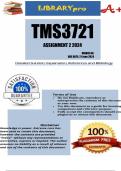TMS3721
ASSIGNMENT 2 2024
UNIQUE NO.
DUE DATE: 21 June 2024
, TMS3721
Assignment 2 2024
UNIQUE NO.
DUE DATE: 21 June 2024
Teaching Life Orientation in Further Education and Training
UNISA@2024
, QUESTION 1
A theory is a set of principles or ideas that explain a phenomenon or provide a
framework for understanding certain aspects of the world. In education, theories offer
structured ways to think about teaching and learning. For Life Orientation teachers,
these theories can be incredibly valuable tools for addressing the diverse learning
needs of students in the Further Education and Training (FET) Phase.
Diverse learning needs in the classroom refer to the different ways students learn best.
These differences can be due to various factors such as cultural background, language,
learning styles, and individual strengths and weaknesses. Some students might grasp
concepts quickly through visual aids, while others may need hands-on activities or more
time to process information. Recognizing and catering to these differences is essential
for effective teaching.
Educational theories like Howard Gardner's Theory of Multiple Intelligences, Vygotsky's
Social Development Theory, and Bloom's Taxonomy can help Life Orientation teachers
understand and address this diversity. Gardner’s Theory of Multiple Intelligences, for
example, posits that students have different kinds of intelligences—such as linguistic,
logical-mathematical, musical, and kinesthetic—and thus learn in different ways
(Gardner, 1983). By identifying the dominant intelligences of their students, teachers
can tailor their teaching methods to meet these varied needs.
Vygotsky’s Social Development Theory emphasizes the importance of social interaction
and cultural context in learning (Vygotsky, 1978). According to this theory, teachers can
support students' learning by providing opportunities for collaborative work and by
scaffolding instruction—offering support structures to help students move beyond their
current abilities.




